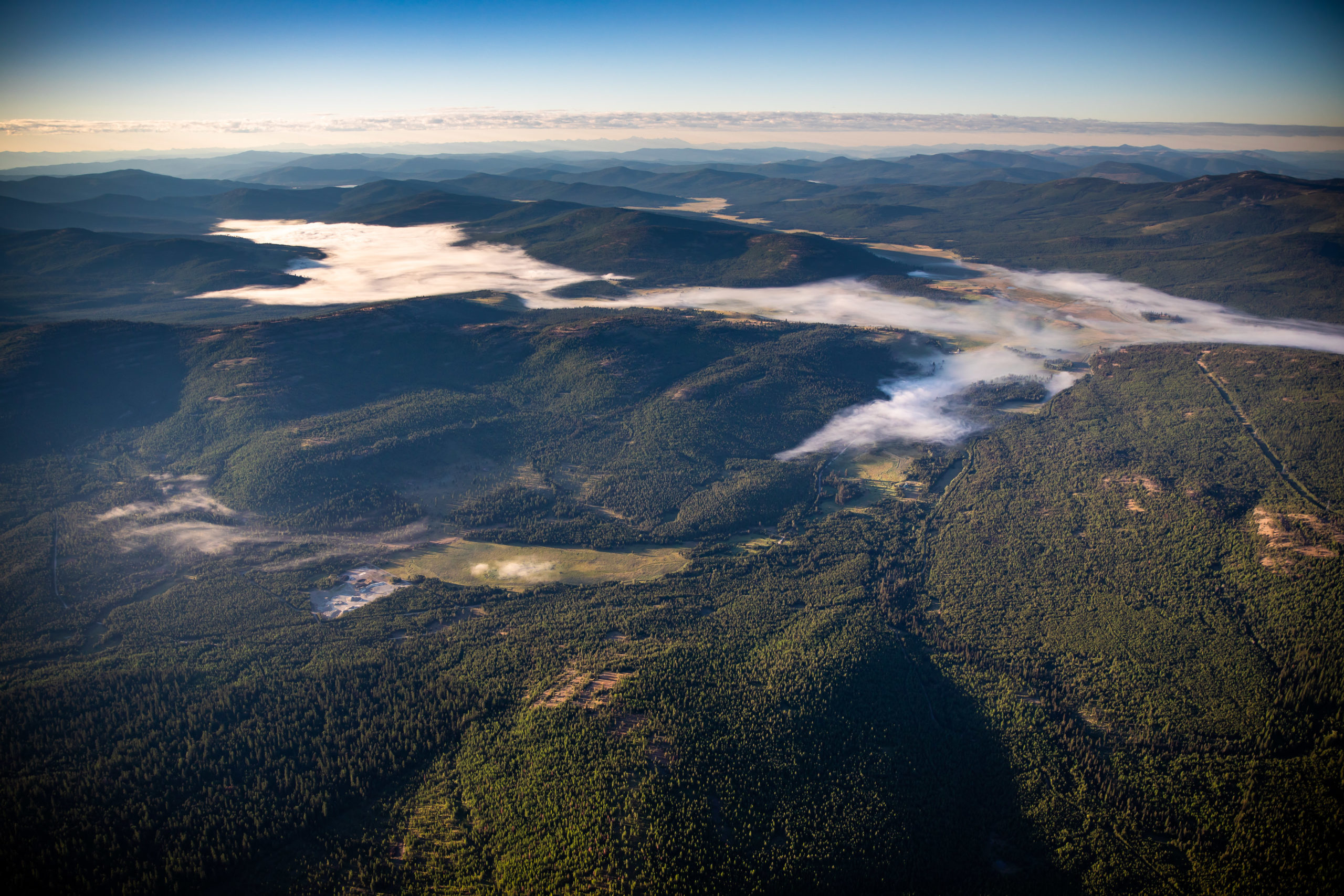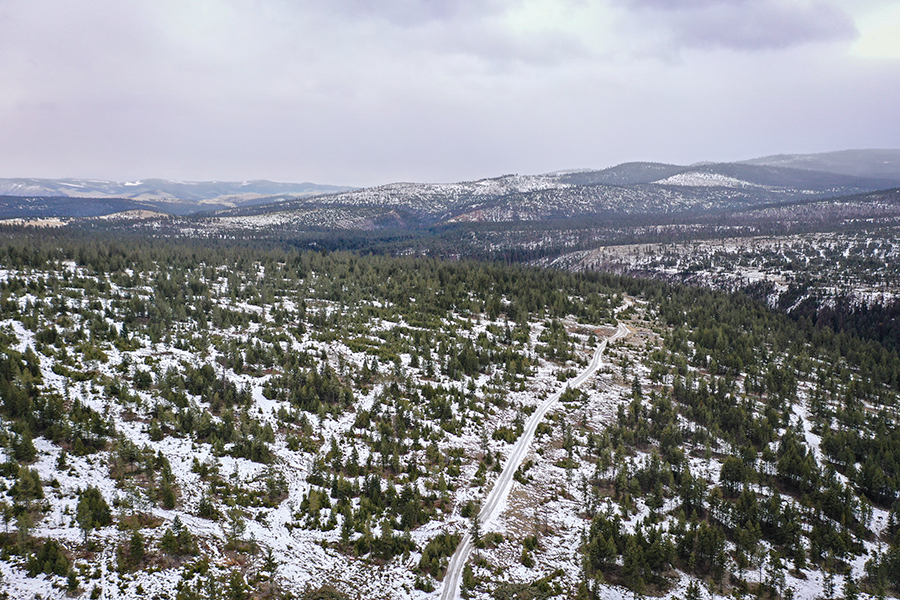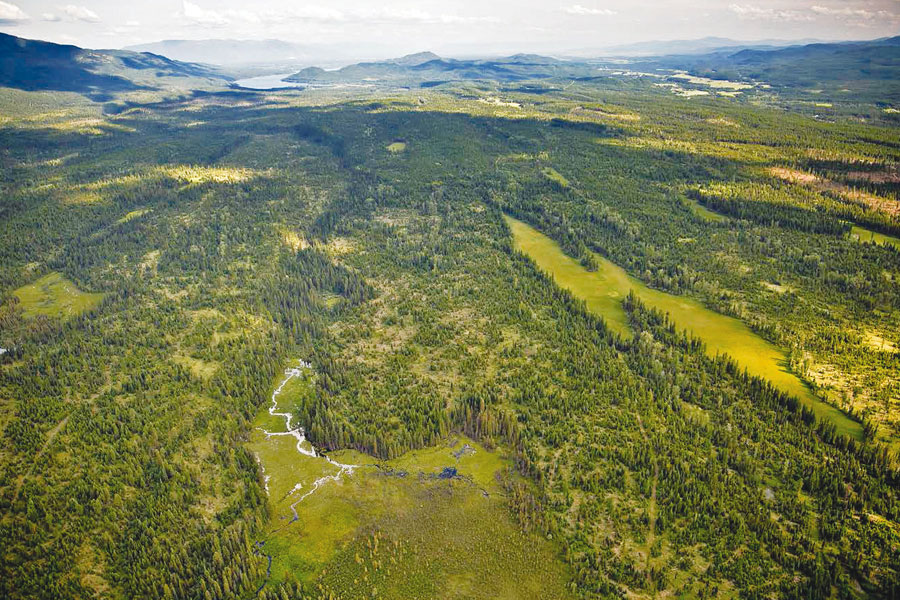This Land is Whose Land?
With hundreds of thousands of timberland acres changing hands in recent years in Northwest Montana, difficult questions over access and usage are coming into focus alongside the region’s legacy of conservation
By Tristan Scott
In December 2019, the week before Christmas, the Washington-based timber giant Weyerhaeuser Co. announced in a statement to shareholders that it was selling all 630,000 acres of its remaining Montana timberland to a private investment company for $145 million in cash, sending shockwaves across the region.
With scant details about the new landowner or its intentions with the sprawling acquisition, the news knocked stakeholders back on their heels, with everyone from crunchy tree huggers to wizened tree cutters, as well as hikers, hunters, houndsmen, and homeowners, bracing for the worst-case scenario.
“It’s unclear if they’re going to manage it for timber production or split it up and put big expensive resorts on it,” Julia Altemus, executive director of the Montana Wood Products Association, told the Beacon at the time. “I can’t even speculate because we have no other information.”
Others were plenty eager to speculate, particularly since large publicly traded landowners in the West had been selling off vast swaths of forest as prices for agricultural and timberlands slumped, and the prospect of carving up tracts into more lucrative residential parcels gained allure to shareholders.
But before joining in the Montana gold rush, industry leaders like Plum Creek Timber Co., which was absorbed by Weyerhaeuser in 2015 to form a $23 billion Real Estate Investment Trust (REIT) — making Weyerhaeuser the largest private owner of timberland in the nation — had helped preserve portions of its western Montana inventory through conservation easements, while allowing public access on its timberlands through cooperative management agreements with state agencies like Montana Fish, Wildlife and Parks (FWP).
With the 2019 announcement of the Weyerhaeuser takeover, including 880,000 acres in Montana, the future of those agreements hung in jeopardy.
“A collective shudder ran down all our spines, not just for those of us in the conservation community but also for land managers and the timber and outdoor recreation industries, because all those private lands have been de facto public lands for decades and they were suddenly at risk,” Dick Dolan, the Northern Rockies director for the nonprofit The Trust for Public Land (TPL), recalled in an interview last week.
Up until that point, TPL and organizations like it had made their existence negotiating deals to secure conservation easements on properties like the one Weyerhaeuser had just sold, inking contracts to protect lands from residential development while ensuring its timber was actively managed, its wildlife habitat left intact and its surrounding watersheds unsullied. In 2003, TPL helped broker the $34 million, seven-year effort to preserve the Thompson and Fisher river valleys from development, setting aside what at the time was the largest conservation easement in Montana history, protecting a wide swath of Plum Creek’s commercial timberland from subdivision while allowing continued timber management and logging.
Another Herculean effort came to fruition in 2008, when TPL joined forces with The Nature Conservancy (TNC) to establish the Montana Legacy Project, erasing a fractured pattern of ownership that intermingled private and public lands in a checkerboard, and conserving more than 300,000 acres of private Plum Creek forestlands in perpetuity. Like the Thompson-Fisher deal, it also provided multiple-use benefits to the public while keeping private development at bay, including along the Swan River Valley and on lands surrounding Missoula and Lolo Pass.
“That was a great, great outcome,” Dolan said, “and we have been working since then on successful projects to conserve even more sensitive private lands.”
In Northwest Montana, some of those more recent efforts include adding 13,398 acres of private forestland to the Stillwater State Forest west of Whitefish; securing easements on F.H. Stoltze Land and Lumber Co. parcels surrounding Haskill and Trumbull creeks between Whitefish and Columbia Falls; and furnishing permanent protections on 28,000 acres in the Kootenai River Valley near Troy.
“It’s been a steady rate of progress,” Dolan said. “But then you fast forward to a little over a year ago, when we were just starting to grapple with the fact that Weyerhaeuser was selling 650,000 acres of forestland, and probably no more than 200,000 acres of that land had any protections. So we were looking at 400,000-some-odd acres that were possibly going to get privatized and gated and sold, the timber supply gone and the public locked out. We knew right away there needed to be some way to keep it from being sold to the highest bidder and chopped up in small chunks and sold to developers. And one tried and tested way to do that is to set up these conservation easements. But we need willing partners.”

Enter Southern Pine Plantations (SPP), a real estate investment company based out of Macon, Georgia, who at the end of 2019 revealed that it was the mysterious new owner of the Plum Creek property. With a track record of flipping large chunks of private forestland in the western and southeastern U.S., including selling parcels for private development in Idaho’s Payette River Valley, SPP’s sudden presence on the Montana landscape wasn’t immediately met with open arms.
But within days of its announcement, SPP attempted to put those concerns at ease when it announced it would continue the long-standing practice of allowing public access to hunters, anglers and other land users, even as the company’s owners kept their long-term plans for the property to themselves.
“We’ve been negotiating to buy that Plum Creek property for over 15 years,” Pat Patton, president of SPP who manages the company’s Montana holdings, said last week. “But back then we were competing with The Nature Conservancy, which was paying a pretty high price per acre. We are in the timberland business, so we buy land, we keep land, and we sell land. We love land. It’s what we do.”
“But the timber markets were kind of dwindling in Montana, so we saw it as an investment opportunity,” he continued. “And the conservation easements were a pretty good investment.”
As SPP’s plans materialized during the course of 2020, it became evident that the company realized the benefits of continuing down the path of conservation, particularly after it completed the Lost Trail Conservation Easement, closing on a deal last month with FWP. It then entered into an option with TPL on 55,000 acres in Flathead and Lincoln counties on a project referred to as the Lost Trail Expansion Project, a conservation easement that, if approved, will be held by the U.S. Fish and Wildlife Service (FWS). And SPP entered into another option with TPL on 130,000 acres in Flathead and Lincoln counties referred to as the Montana Great Outdoors Project, which will be held in a conservation easement by FWP as part of the agency’s Forest Legacy Project. SPP also contracted with TPL to sell 15,000 acres in Missoula County to the nonprofit’s Missoula Front Country Project, which will be owned fee simple by the U.S. Forest Service (USFS).

Meanwhile, the Thompson-Fisher Conservation Easement already existed on 111,000 acres of the land SPP purchased from Weyerhaeuser, and those acres remain intact, despite SPP’s decision to sell 291,000 acres to Green Diamond Resource Company, a family-owned timber firm that owns working forest lands in Washington, Oregon and California, and which assumes the terms of the easement while pledging to complete the ongoing work with TPL, FWP and FWS.
“Assuming all these projects are fully supported and eventually funded, over 333,000 acres would be open to the public for recreational access and continued forestry management operations in perpetuity,” Eric Moody, SPP’s land specialist, said. “While every acre isn’t protected, and some changes may come, many, many more acres are now protected or set up to be protected than at this point in 2020.”
As of Feb. 12, Patton said the company is “basically done” with large land sales, following the series of conservation easements and the sale to Green Diamond, as well as selling off smaller parcels to private investors.
“I personally feel good about what we have done,” Patton said, adding that he purchased some of the land for himself. “I can sleep at night. And that hasn’t always been the case with what we have done. Sometimes you have a plan and it doesn’t go the way you want. But I feel good about this one and some of us will be part of this community with the land we are purchasing. I think it turned out to be pretty good.”
But the company’s final transaction is also among its largest, and received by far the most attention in the press.

That sale occurred last month, when SPP sold 125,800 acres to a wealthy couple from Texas, Mark and Robyn Jones, who are now one of the largest private landowners in the region, along with family-owned timber companies Stoltze, Stimson and Green Diamond. The Joneses’ new acquisition straddles U.S. Highway 2 near McGregor Lake and runs south past Hubbart Reservoir to the Flathead-Sanders county border before tracking east to Lake Mary Ronan and nearly to the western shore of Flathead Lake.
Through their newest holding, dubbed Flathead Ridge Ranch LLC, the family will continue to manage the existing timber supply, which has dwindled considerably in the wake of logging pressure from Plum Creek, but the primary goal will be to conserve the land, Mark Jones told the Beacon.
“This is not an economically oriented investment. It is a family legacy investment,” he said. “We are going to enjoy it and we hope that our great, great, great grandkids can enjoy it, too.”
Still, the sale raised anxieties among hunters, anglers, hikers, and other land users who’ve grown accustomed to accessing the land through a handshake agreement with the previous owners, as well as through FWP’s block management program, which allows access to private parcels during hunting season in exchange for an enforcement presence by state game wardens.
Settling concerns among outdoor recreationists and state officials for the time being, Jones said an unofficial version of the cooperative access agreement with FWP would continue while negotiations are underway on how to move forward with a more permanent arrangement, the details of which haven’t been made public.
But Jones emphasized that his plans to move forward with an agreement to allow continued access on much of the property will be contingent on the conduct of public users.
“It is our intention going into this to be good neighbors, but being good neighbors is a two-way street,” Jones said. “We hope that the public who wish to use this land is committed to being good neighbors, too.”

Whether or not the good-neighbor arrangement is attained through enrollment in FWP’s cooperative access program, or if another easement is in the works, remains to be seen. But both economic and conservation opportunities remain on the landscape, particularly since Congress authorized full and permanent funding of the Land and Water Conservation Fund (LWCF), with annual allocations of up to $900 million for conservation projects, which has occurred just once in the program’s 57-year history.
“In the 22 years that I worked for Plum Creek, we did a lot of conservation, and I feel good about that work,” Jerry Sorenson, Plum Creek’s former real estate manager who retired in 2015, said. “More often than not the emphasis was on conservation easements, but those deals were always dependent on federal money through LWCF. But we liked conservation easements because we could continue to manage for timber.”
With the recent availability of additional funding through LWCF, Sorenson said opportunities for conservation will only increase.
“Some of the current projects in the works, like Lost Trail, we talked about that for years, but there just wasn’t the funding available,” Sorenson continued. “Now with LWCF being fully funded, I think there’s probably a lot more opportunity to get those projects and others like it completed, so long as there are willing landowners.”

Today, the landscape of Northwest Montana has hundreds of thousands of acres of private forestlands that have been conserved in perpetuity as working forests with multiple-use benefits, and most of them bear Alan Wood’s fingerprint.
The now-retired science program supervisor at FWP for more than two decades helped orchestrate complex land deals between the state and private owners, and his work has helped achieve landscape-scale habitat conservation.
Wood agrees with Sorenson — with whom he often sat at opposite ends of the negotiation table — about the prospect for more and greater conservation opportunities, but he stressed the need for greater public cooperation and understanding when it comes to land stewardship.
“How do you manage public recreation on what was corporate timberland, and what enforcement role does the state play, if any?” Wood said. “Those are issues that need to be addressed. It’s private land and people are allowed to use it. But the owners don’t have staff dedicated to managing it. We kind of kicked the can down the road, and the can came to rest this past year.”
Public land managers and private owners alike saw the pressures of land use rise to full froth last summer as the coronavirus pandemic drove people into open spaces at unprecedented levels, overwhelming state and federal lands and underscoring the need for better education and enforcement.
As private landowners and state agencies like FWP look to “fill in the conservation gaps,” Wood said, it’s imperative that public land users demonstrate responsibility.
“I’m optimistic,” Wood said. “A lot has been done, but there’s a lot more to do, and it is very dependent on how we treat the land.”
“The alternative is no trespassing signs and gates and armed guards,” TPL’s Dolan said. “But I have to say, if you tracked back to December of 2019, when we didn’t know what was going to happen, and asked me then whether having half of those lands conserved with permanent public access would be a good outcome, I would have to say it’s be a pretty good outcome. Are we going to work to make sure that more is conserved? You bet. But it’s not a bad place to be for Montana right now.”